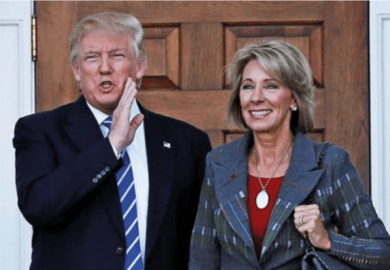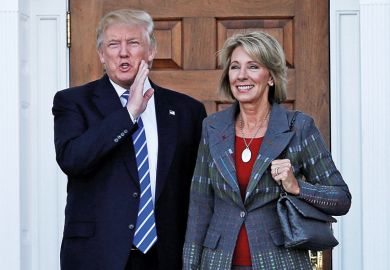One round into its plans for an extensive overhaul of key rules governing US higher education, the Trump administration is backing off, at least for the moment.
After putting forth ideas derided in academic circles as open invitations for unqualified companies to pose as publicly financed colleges, the administration’s top higher education official offered a series of pullbacks and even apologies.
“Clearly we came to the table with some very provocative ideas,” said Diane Auer Jones, the principal deputy undersecretary for higher education at the US Department of Education. “We did that to open the conversation.”
In an address to the annual conference of the Council for Higher Education Accreditation in Washington, Ms Jones then listed a series of specific administration proposals that she did not actually expect would be implemented. Those proposals include removing existing standards for defining a credit hour of class work, ending requirements for “regular and substantive” student-teacher interactions, and ending any role of states in deciding qualified providers.
The proposals are part of an expansive round of talks with the higher education community aimed at revising the rules by which government-endorsed accrediting agencies affirm the eligibility of colleges to have their students receive federal financial aid. The talks began in January, and are expected to resume in mid-February and conclude in March. By law, the process is considered consultative, aimed at winning consensus positions. Administrations, however, ultimately hold the right to make regulatory changes that comply with existing laws.
That leaves fairly wide discretion. The sum of the Trump administration’s proposed changes, said Barmak Nassirian of the American Association of State Colleges and Universities, would dramatically lower if not eliminate barriers to profit-making enterprises using federal student aid money to serve as universities and even accreditors, with existing institutions then forced to honour the academic credits that they issue.
“This is an experiment on live subjects, and most of the risk is borne by students and taxpayers,” said Mr Nassirian, the association’s director of federal relations and policy analysis.
Ms Jones, however, explained that her administration removed major chunks of regulatory language from its proposal without offering replacements largely as a means of stimulating wide-ranging discussions of what alternatives could be devised.
“We’re trying a somewhat different approach this time,” she told the accreditor group. “And I have to tell you that, you know, you learn.”
But Ms Jones held firm on some aspects of the administration’s plan, including its goal of ending the perceived reputational differences between the six long-standing “regional” accreditors and the “national” accreditors that typically serve online and other lower-quality institutions. Among its methods of accomplishing that, the administration has suggested new limits on the regional bodies, which are more highly regarded.
“We do want to address this narrative that somehow we have a two-tiered system, because in our eyes, there’s one tier,” Ms Jones said.
Register to continue
Why register?
- Registration is free and only takes a moment
- Once registered, you can read 3 articles a month
- Sign up for our newsletter
Subscribe
Or subscribe for unlimited access to:
- Unlimited access to news, views, insights & reviews
- Digital editions
- Digital access to THE’s university and college rankings analysis
Already registered or a current subscriber?








